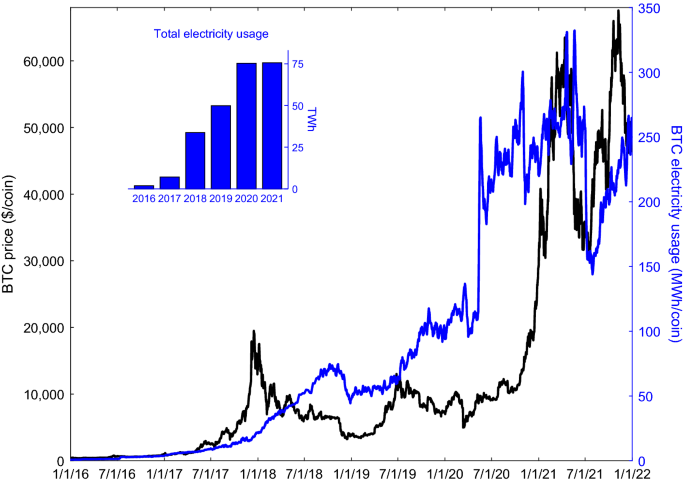Economic estimation of Bitcoin minings climate damages demonstrates closer resemblance to digital crude than digital gold – Scientific Reports
Bitcoins global electricity usage
Using network hash rate data from January 2016 through December 2021 and data on mining equipment power consumption and efficiency5,30, Fig.1 presents global electricity usage of mining BTC and prices per coin. On the basis of these estimates, in 2020 BTC mining used 75.4TWh yr1 of electricity, which is more energy than used by Austria (69.9 TWh yr1 in 2020) or Portugal (48.4 TWh yr1 in 2020)31. There is a general upward time trend in BTC electricity use and a close correlation between BTC prices and mining energy usage. The decline in BTC exchange prices and mining energy use in the summer of 2021 is likely due in part to Chinas banning of financial institutions and payment companies from providing cryptocurrency-related transactions32.

Global 7-days averaged daily electricity usage of mining activity (right axis) and coin exchange price in US$ (left axis) for Bitcoin (BTC). Data from January 1, 2016 to December 31, 2021 shown. Electricity usage is calculated based on network hash rate data downloaded from Blockchain Charts (https://www.blockchain.com/charts) and mining rig efficiency (see Methodssection). Prices downloaded from Yahoo! Finance (https://finance.yahoo.com/cryptocurrencies/). All network hash rate and price data are supplied in the Supplementary Data.
Estimates from Cambridge University suggest the majority of electricity used to mine POW cryptocurrencies comes from coal and natural gas, though hydropower use was likely prominent in China until cryptocurrency mining was banned there32,33. Globally, it is estimated that 39% of POW mining is powered by renewable energy, meaning that non-renewables, such as fossil fuels, power the majority (~61%)33. Due to its considerable fossil fuel energy use, cryptocurrency mining contributes to global carbon emissions30,34 with associated environmental damages35. Goodkind et al.29 estimated that in 2018 each $1 (US$) of BTC market value created through mining was associated with $0.49 (US$) in combined health and climate damages in the US and $0.37 (US$) in China. Krause and Tolaymat5 estimated that BTC, Ether, Litecoin, and Monero coins were responsible for 315 million tonnes of CO2 emissions over January 2016 to June 2018. For comparison, in 2018, similar amounts of CO2 were emitted from Afghanistan (7.44 million tonnes), Slovenia (14.1 million tonnes), and Uruguay (6.52 million tonnes)36.
Climate damages associated with bitcoin mining
As mining efforts have increased over time, we estimate steeply increasing CO2e (carbon dioxide equivalent) emissions per coin created. Using a global estimate of the location of BTC miners and the local electricity mix, and regional CO2e emission coefficients by generation type37, a BTC mined in 2021 is responsible for emitting 126 times the CO2e as a BTC mined in 2016increasing from 0.9 to 113 tonnes
